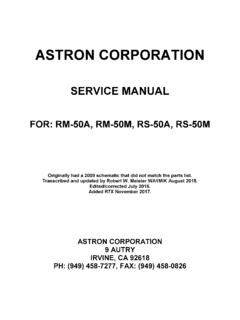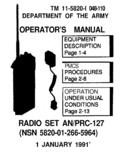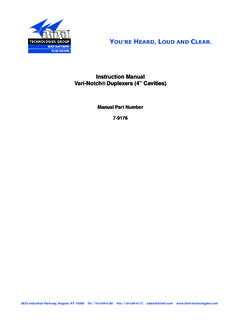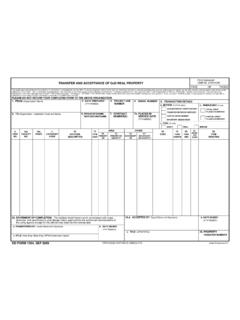Transcription of Practical Noise-Figure Measurement and Analysis for Low ...
1 Application Note 1354 Practical Noise-Figure Measurement andAnalysis for Low- noise Amplifier Designs2 Table of contentsIntroduction ..2 The design process ..3 Software modeling ..3 Functional requirements ..3 Selecting a device ..4 Raw device modeling ..4 Device matching ..5 Design completion ..5 Design verification ..6 Performance simulation ..6 Layout and prototype ..6 Design fine-tuning ..7 Performance measurements ..7 Network measurements ..7 Narrow band NF measurements ..8 Receiver sensitivity ..8 Why measure narrow band NF? ..8 Narrow band example ..9 Measuring narrow band NF ..9 Microwave NF measurements ..10 Swept LO ..10 Swept IF ..11 Mixer and receiver NF measurements ..12 Measurement uncertainty ..13 Extraneous signals ..13 Nonlinearities ..14 Instrumentation uncertainty ..14 Excess noise ratio (ENR) uncertainty.
2 15 Mismatch uncertainty ..15 Instrument architecture uncertainty ..16 Instrument NF ..16 Unwanted in-band power ..16 Overall uncertainty ..17 IntroductionUnderstanding and accurately measuring noise figure(NF) in low- noise elements has become particularlyimportant to the development of next-generationcommunications systems. This application noteexamines the process of making Practical Noise-Figure (NF) measurements of low- noise amplifiers(LNAs) a capability that can have a significantimpact on cost, performance, and required designtime for wireless examination begins by looking at a representativeLNA block design. Software simulation is leveragedas a vehicle for demonstration and provides a bench-mark for subsequent NF Measurement and design example reveals the typical steps requiredto take an LNA block from concept to production. Atthe prototype stage, actual NF measurements can betaken, and the data compared with simulated nearly 20 years, standard techniques and methodsfor measuring the NF in LNAs for wireless receiversserved the emerging commercial industry well, andhave remained relatively unchanged.
3 But over thepast few years, the performance of RF systems hasimproved significantly, placing tighter limits on NFspecifications and greater Measurement of the important features available in contem-porary NF analyzers are a step further, narrow bandwidth NF measure-ment concepts and requirements are instance, a bandpass filter is combined with anamplifier block to yield a suitable method for makinga Practical narrow-band Measurement . Further, NFmeasurements for frequency-conversion devices andsystems are explored, as well as consideration ofvarious options for measuring NF at microwave the performance of RF devices continues to improve,assessing NF Measurement uncertainty becomesincreasingly valuable. The primary componentsaffecting ambiguity in Measurement are presented,as well as a useful methodology for approximatingthe overall effect of Measurement design processLNA design typically begins by assessing functionalrequirements for the application.
4 Candidate devicesare then selected based on specifications includingNF, stability, unilateral gain, and dynamic range. Theactual design work starts with S-parameters andchoice of an appropriate bias technique for the device,followed by synthesis of matching networks. Layoutincludes choosing vendor-specific parts, adding inter-connections and pads, followed by floor performance is then analyzed, and the design isoptimized to assure requirements can be met usingspecific vendor parts. Finally, the overall design modelingThe development of cost-effective amplifier designsfor wireless communications systems would be virtually impossible without the use of advancedsoftware-based modeling technology. Today s high-caliber tools typically provide an easy-to-use hierar-chical, windows-based user interface as illustrated inFigure requirementsFor illustration, the example amplifier is intended fora handheld phone application, and will require a gen-eral low- noise receiver front-end to cover the mobile phone bands.
5 Additional functionalrequirements are listed below. Frequency range: NF: <1dB Gain: >10dB VSWR: < :1 Supply voltage: 3 VThe sub 1dB NF is important in this application, takingon even greater importance than voltage standing waveratio (VSWR). However, a VSWR of :1 or better isstill highly desirable. Since the design is intended fora portable device, low voltage operation using a 3-voltbattery is required. Cost is also a key constraint,while space is slightly less critical. A distributed,microstrip matching circuit will therefore be used tominimize component 1. Tools such as Agilent s Advanced Design System (ADS) provide an intuitive,windows-based interface. Throughout this document, ADS is utilized to demonstrateall models, schematics and simulation results. The Main window in ADS, shown atthe upper left, serves as a file manager and a portal to other ADS windows such asthe Layout or Schematic & Test Bench windows.
6 The Graphic Server window (upperright) offers a visual means of viewing, printing, and analyzing data from a deviceAlthough an array of process and device technologiesmay be suitable for the intended application, theselected device for this example is an ultra low-noiseamplifier fabricated in a pseudomorphic high-electronmobility transistor (PHEMT) gallium arsenide (GaAs)process. The device features NF, +14dBm third-order intercept point, and gain at 2 GHz, 4V,60mA. The transistor is optimized for to PCS low- noise amplifiers (LNAs). The widegate width of the this device exhibits impedancesthat are relatively easy to match, and the 1dB NFrequirement should also be easy to meet. The S-para-meters and noise parameters for this device areshown in Figure device modelingThe schematic of the amplifier device, shown inFigure 3, reveals some source resistance for self configuration forces the gate negative withrespect to the source, allowing the drain current tobe set with the source resistor (Rs=Vgs/Id).
7 This simple biasing technique is very appealing, since itreduces the overall parts count. The source resistoris AC bypassed, using a low-impedance capacitorwith the desired operating model accounts for through-hole vias and selectedsource inductances produced by the printed circuitboard. Some source inductance can be beneficial,because of its impact on input impedance and low-frequency stability. On the other hand, too muchinductance can cause high-frequency gain peaking,which results in oscillations. With an 800 micron gatewidth, the device in the example design exhibits rea-sonable tolerance to these effects. However, theseparasitics need to be included in the model sincethey affect input and output impedance, which mustbe Smith chart in Figure 4 provides a convenientway to examine the various impedances for the tar-get device, which in turn can be leveraged to synthe-size an appropriate matching 2.
8 S-parameters and noise parameters for the ultra-low noisetransistor in the design example (the Agilent ATF-34143). The file, asshown, is downloadable from the Agilent website formatted for usedirectly with 3. This is the basic schematic of the amplifier using the ultra-low- noise ATF-34143 transistor. The model represents the raw devicewith source resistance indicated for a self-biased 4. Simulated noise and S-parameters for the transistor model,with S11, S22 and NFmin plotted on a Smith matchingFrom the Smith chart it is clear that the device exhibitssome capacitive behavior. Therefore, the matchingnetwork can be a simple high-pass impedance circuitfashioned from a series capacitor and shunt inductoras seen in Figure high-pass topology is especially well suited forpersonal communications services (PCS) and wirelessLAN applications since it offers sufficient low-frequencygain reduction, which can minimize the amplifier ssusceptibility to cellular and pager transmitter over-load.
9 A similar high-pass structure is used for theoutput impedance matching network, which is opti-mized for best-return loss and output are a number of options to determine componentparameters for the matching network. Manual calcu-lation using the device s impedances represents themost basic approach. Alternately, while most engineersare reluctant to use the Smith chart, it provides asimple, intuitive way of manipulating impedance, andtherefore developing matching networks. Modelingsoftware is another method of synthesizing and opti-mizing matching networks based on input and completionAfter the initial optimization, finishing touches can bemade to the amplifier model. Inductors are replacedwith distributed elements and discrete componentsare replaced with parts from vendor libraries as seenin Figure 50 resistor between the input inductor andground provides a DC return for the gate terminal ofthe device.
10 This also supplies an effective low-frequencyresistive termination for the device, which is necessaryfor stable device operation. In addition to being partof the matching network, the output inductor doubles as a way of decoupling the power all components defined and the effects ofthrough-hole vias included in the model, the circuitis once again optimized and its performance isassessed. At this point, parameters and componentscan be re-tuned if 5. Since the device is capacitive, a simple high-pass impedancecircuit can be used for the matching 6. Here are the synthesized matching circuits for the ultra-low- noise transistor example. After requirements for input and output returnloss, NF and gain are entered, the software optimizes matching circuitparameters for best results. Inductances are substituted with distributedelements and discrete components are replaced with behavioral modelsof actual parts from vendor verificationPerformance simulationWhen the finished design is simulated, it looks likethe effort is on track so far.

















